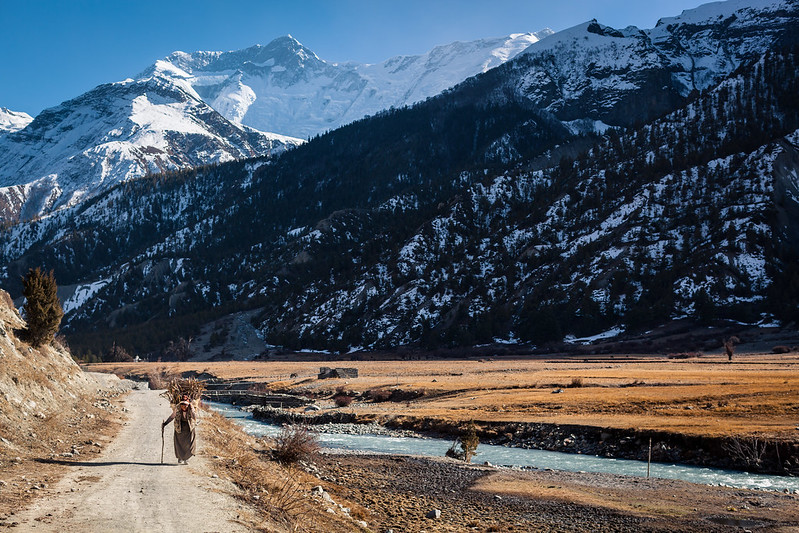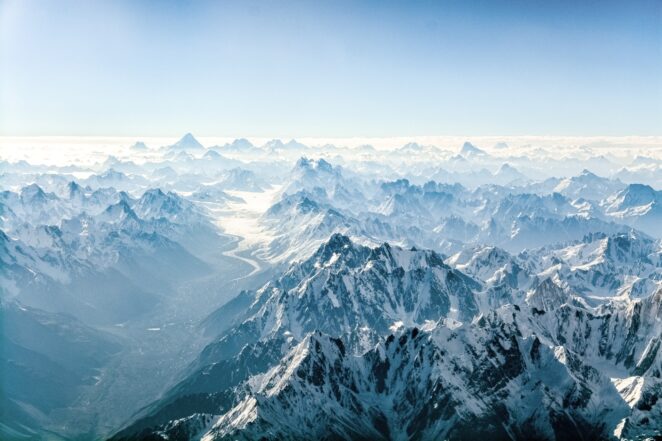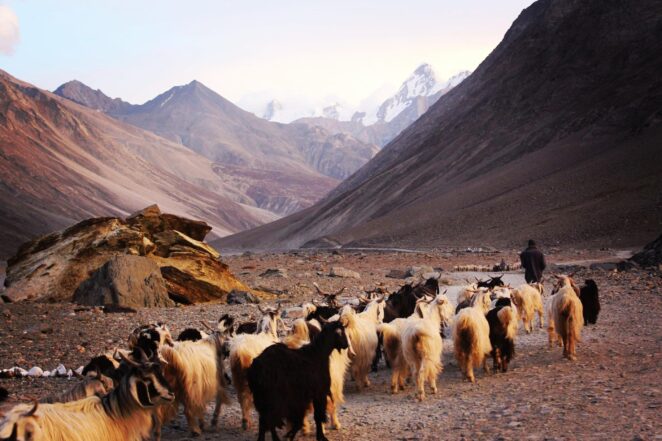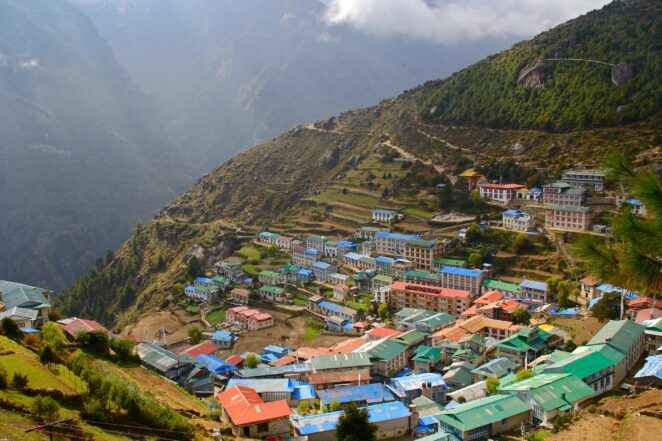Glacial lake outburst floods: A shared risk across the Hindu Kush Himalayas

Introduction
This story is repostedfrom the Stockholm Environment Institute website and draws on research by the International Centre for Integrated Mountain Development (ICIMOD), an Adaptation Without Borders partner based in Nepal. It is part of a set of 4 case studies on transboundary climate risks which can be accessed here.
The Hindu Kush Himalayas is sometimes called the “Third Pole”, due to having one of the world’s largest concentrations of snow and glaciers. But with the acceleration of the effects of climate change, the glaciers are retreating rapidly. Between 1977 and 2010, Nepal lost almost a fourth of its glacier areas, and glacier losses are projected to continue worldwide as temperatures continue to rise.
This case study looks at how glacial lake outburst floods (GLOFs) affect the Hindu Kush Himalayas.
GLOF along the Bhote Koshi River
On 5 July 2016, a catastrophic flood ravaged communities along the Bhote Koshi River in eastern Nepal. The ground shook from the force of the tsunami-like volumes of water, which carried boulders as large as six metres wide and tore across the landscape.
Overnight, 20 concrete houses, a boarding school and parts of a customs office were swept away, and dozens more buildings were damaged. Large stretches of roads fell apart, including along a highway that links Nepal to China; a hydropower plant was severely impacted. Rapid evacuations and rescue missions prevented deaths, but the economic damages were estimated at about $70 million.
The disaster occurred amid heavy monsoon rains, so the cause was not immediately obvious. However, satellite images later showed it was a glacial lake outburst flood GLOF. Gongbatongshacuo Lake in Tibet Autonomous Region, China, breached its moraine dam, releasing some 100 000 m3 of water. Seismometers installed along the river after the 2015 earthquake were found to have captured two distinct waves, less than an hour apart: first an enormous amount of water, then a burst of coarse sediment.
A land of (melting) glaciers
The Hindu Kush Himalayas have the largest concentration of snow and glaciers outside the polar region, leading them to be called the “Third Pole”. The glaciers and glacial lakes that dot the landscape are vital sources of water. With climate change, the glaciers are retreating rapidly; from 1977–2010, Nepal lost 24% of its glacier areas and significant glacier losses are projected to continue worldwide even if the global temperature increase is limited to below 1.5°C.

The meltwater is increasing the number of glacial lakes and expanding existing ones. Since 1990, the number and volume of glacial lakes has grown by about 50% globally. And with increasing frequency, the water is bursting through the lakes’ fragile, crumbly dams. The causes of GLOFs are complex: some are related to climate change, while others are not. Along with glacial melt, extreme rainfall can raise water levels, while earthquakes and avalanches can destabilize the ground.
Since 1977, Nepal has recorded 26 GLOFs that have caused significant losses and damages – 11 of them originating outside its borders. GLOFs in the Hindu Kush region are a prime example of transboundary climate change risks. More than 85% of high- and very high-risk transboundary water basins in the Himalayas are close to the border between China and Nepal. All three major river systems of Nepal (the Koshi, Narayani and Karnali) originate in Tibet and of the more than 3,600 glacial lakes in those river basins, more than 1500 are in Tibet. A detailed inventory in 2020, prepared to inform Nepal’s climate policies, found 47 glacial lakes could pose dangerous GLOF risks: 25 of them are in Tibet.
Not only can GLOFs in one country cause devastation in another, as those who experienced the Bhote Koshi River flood of July 2016 know firsthand, but the profusion of glacial lakes in the region, close to one another, raises concerns about a cascading scenario: the outburst of one glacial lake could trigger other GLOFs downstream, with even more devastating consequences.
Adaptation is a regional challenge
Disaster risk reduction (DRR) measures can help identify, assess and reduce the risks of GLOF events, but in the Hindu Kush region, interventions to date have been inadequate. In particular, early-warning systems are lacking, with only three sensor and monitoring-based technical systems set up in the region – two in Nepal, and none operating across borders. To date, transboundary GLOF risks has rarely been mentioned in Nepal’s adaptation strategies and cross-border cooperation on DRR remains limited.
Governments in the region have taken some promising steps. In 2018, India, Nepal, Bhutan, Pakistan and Afghanistan set up the Hindu Kush Himalaya Glaciers and Mountain Economy Network to help design joint strategies to combat climate change impacts in the region, with a focus on glaciers.

The International Centre for Integrated Mountain Development (ICIMOD), which has done extensive research on GLOFs and climate change in the Hindu Kush region and is a partner in Adaptation Without Borders, has been working to raise awareness of transboundary climate risks and foster cooperation to address them.
For example, the Koshi Basin Initiative aims to reduce the vulnerability and improve the livelihoods of communities in the river basin, which is shared by China, India and Nepal. ICIMOD has also established a DRR knowledge hub and it piloted a community-based flood early warning system to reduce flood risks along the Ratu River, which is shared by Nepal and India. That project could serve as a model for how to reduce the vulnerability of people in Nepal who are exposed to transboundary GLOF risks.

The Ulaanbaatar Declaration, adopted at the 2018 Asian Ministerial Conference on Disaster Risk Reduction, calls for a regional approach to reducing vulnerability to climate change. China and Nepal have also agreed to cooperate on environmental protection, which could be used as a stepping stone for transboundary risk management.
A potential example to emulate is the joint effort by Afghanistan and Tajikistan to address transboundary risks in the Pamir mountains – starting with Sarez Lake, a body of water formed after an earthquake that, if it were to collapse, could put as many as 5 million people at risk in Afghanistan, Tajikistan and other countries. With support from development partners, the neighbouring countries have signed three bilateral agreements since 2010, on hydrology, disaster management and environment protection.
Given political tensions and lack of trust among countries in the Hindu Kush Himalayas, cooperating to reduce transboundary GLOF risks is not without challenges, but it is an urgent necessity. Only by recognizing their shared interest can they adapt effectively, systematically mapping and monitoring potential risk zones and designing regional DRR frameworks to protect their people.
(0) Comments
There is no content